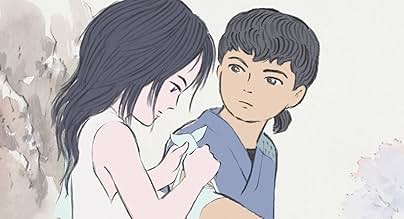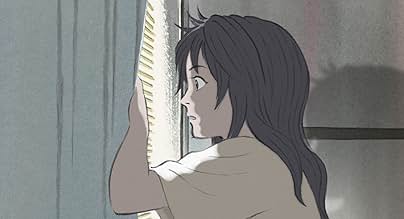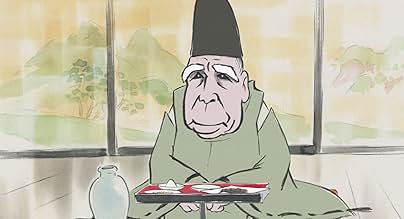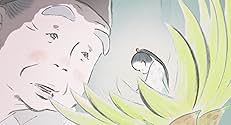Ein alter Bambussammler und dessen Frau finden in einem leuchtenden Bambushalm eine winzige Prinzessin, die schnell zu einer eleganten jungen Dame heranwächst. Die geheimnisvolle junge Prinz... Alles lesenEin alter Bambussammler und dessen Frau finden in einem leuchtenden Bambushalm eine winzige Prinzessin, die schnell zu einer eleganten jungen Dame heranwächst. Die geheimnisvolle junge Prinzessin zieht alle in den Bann, die ihr begegnen - doch schließlich muss sie sich ihrem Schi... Alles lesenEin alter Bambussammler und dessen Frau finden in einem leuchtenden Bambushalm eine winzige Prinzessin, die schnell zu einer eleganten jungen Dame heranwächst. Die geheimnisvolle junge Prinzessin zieht alle in den Bann, die ihr begegnen - doch schließlich muss sie sich ihrem Schicksal und der Bestrafung ihres Verbrechens stellen.
- Für 1 Oscar nominiert
- 13 Gewinne & 38 Nominierungen insgesamt
- The Princess Kaguya
- (English version)
- (Synchronisation)
- The Bamboo Cutter
- (English version)
- (Synchronisation)
- The Bamboo Cutter's Wife
- (English version)
- (Synchronisation)
- …
- Prince Ishitsukuri
- (English version)
- (Synchronisation)
- Kaguya hime
- (Synchronisation)
- …
- Sutemaru
- (Synchronisation)
- Okina
- (Synchronisation)
- Ôna
- (Synchronisation)
- …
- Sagami
- (Synchronisation)
- Menowarawa
- (Synchronisation)
- Inbe no akita
- (Synchronisation)
- Ishitsukuri no miko
- (Synchronisation)
- Abe no udaijin
- (Synchronisation)
- Ôtomo no dainagon
- (Synchronisation)
- Mikado
- (Synchronisation)
- Kuramochi no miko
- (Synchronisation)
- Kaguya hime (child)
- (Synchronisation)
- Voice Appearance
- (Synchronisation)
Empfohlene Bewertungen
I love the way animation can take such simple things as eating a melon or watching birds fly into a tree so much more exciting. By using traditional animation (although I need notice some computerize layouts),The Japanese have done it again with their personal approach to the detail of animation you can only get from 2D.
Adding to my enjoyment, this English adaption of the film includes the voice talent of Chloë Grace Moretz as the princess, who I've become a fan of.
It was very beautiful artwork moving across the big screen.
I believe that "Princess Kaguya" is the best Ghibli film in the past 10 years because of the beautiful hand-drawn animation and touching story.
Japanese audience and critics are also very positive for this film, compared to other Ghilbi films.
Hayao Miyazaki is a genius but his recent films are always controversial since "Haul's Moving Castle".
One of the reason is that he relies on his imagination and makes light of a script. That's why quite a few people can't fully understand his recent films and sometimes blame them. ("The Wind Rises" was a tragedy in this meaning.)
Isao Takahata, the director of "Princess Kaguya", is a very good director known for "The Grave of Firefly" but not so active since "My neighbor the Yamada".
His philosophy is very different from that of Hayao Miyazaki. Isao Takahata thinks the scenario is very important and he prefers realism to fantasy.
"Princess Kaguya" is based on the Japanese oldest folklore "The Tale of the Bamboo Cutter". But Isao Takahata transforms it into a universal humanistic story by describing Princess Kaguya as a realistic girl.
This film contains many fantastic scenes and they play as good eye candies. But the brilliantly illustrated life and emotions of the heroine is the most important part in this film. And that's what the director wants us to try to sympathize.
The beautiful and artistic style of this animation is suitable for this theme. Because this apparently unfinished animation gives us the room to imagine by ourselves.
Isao Takahata says, "The animations tend to deprive children of their own imagination by pushing them someone else's fantasy. We have to make another animation which let them imagine by themselves".
I can't wait to see the responses from the worldwide audience! Hope you will like this film too!
Based on a 10th century Japanese folktale, The Tale of Princess Kaguya is a bittersweet coming of age story. Our protagonist is Kaguya-hime who is discovered as a baby in a bamboo stalk by an old peasant man. He and his childless wife raise her as their own, providing the best they can as she rapidly ages. While her mother is fearful of change and just wants a comfortable life for her adopted daughter, her father envisions great things. He sees Kaguya as part of a divine plan and after fine clothes and gold come shooting out of bamboo stalks he concludes that the heavens want her to become a proper princess. He assumes this is the best way to make his daughter happy instead of asking her what she wants.
A sharply observed feminist critique of traditional Japanese culture as well as a cautionary tale of the burdens we place on our children, The Tale of Princess Kaguya has a wealth of complex themes and archetypes hidden beneath the surface of its fairly straight- forward story. This is one of the rare films that are both easily accessible to a young audience and one that film students can write thesis papers on.
The final word should be reserved for Studio Ghibli's animation. The style used invokes something between impressionist paintings and water-colours while employing a muted palette. Ghibli moves away from traditional anime and the results are breathtaking. The hand drawn frames could each stand alone as a portrait and yet the film feels fluid. At times the animation blurs into expressionism; the brush strokes matching the characters inner- turmoil.
Easily the best animated film of the year, it's a must see for fans of the genre. Luckily North America will get a theatrical release; the English-dubbed version will be out October 17 and will star Chloe Grace Moretz as Kaguya.
It's about an elder bamboo cutter named Okina who discovers a young, tiny girl in a bamboo shoot and decides to adopt her as his own along with his loving wife Ona. As years progress, the tiny girl begins to grow rapidly to normal size like the other children of their village, eventually having to leave since her adoptive parents decide to have her raised among the nobles. From there, she is given the name "Princess Kaguya" and things become further complicated when so much is offered to her so suddenly.
When comparing this movie to past Studio Ghibli efforts, it's obvious that the animation style is nothing like its preceding films. And with studio founder Hayao Miyazaki having stepped down and no involvement with this current project, I have to say it's a drastic, yet vibrant change in what Studio Ghibli is widely known for. I loved the story and it had an ending that was rather heartwarming and enough to tug anyone's heartstrings. With the English dub voice of Kaguya done gracefully by Chloe Grace-Moretz (Let Me In, Carrie, If I Stay), she actually stands out well as the title character, like it wasn't forced.
The animation technique was rather intricate, but it was reminiscent of an old Japanese art painting I've once studied about in Art History classes at my local college. American animation studios have believed traditional 2-D to be a dying art form in the film industry these days, but I can tell Japan does not acknowledge it in that way at all, whether it's TV or film. The concept I started believing for the entire film felt like "a timeless painting" and it's quite a stroke of genius, in my opinion.
The music and underscore of Joe Hisaishi has left me engaged that it flows evenly well with the scenes as they play out. But most notably, director Isao Takahata really stepped up following his involvements with titles like "Kiki's Delivery Service," "My Neighbor The Yamadas," and even the touching "Grave of the Fireflies." This entire movie has earned its rightful place in the Studio Ghibli library. This is another example of a Ghibli film where you don't have to be an avid Japanese Anime fan to enjoy it, what matters is that such themes existed in various genres, not just in one medium or one genre alone.
Wusstest du schon
- WissenswertesIn several scenes in the movie, Kaguma-Hime, Lady Sagami and Ona can be seen wearing multi-layered kimonos called Junihitoe. Both the number of layers and the coloring of the layers worn would be dictated by the occasion, status, and season the wearer is in.
- PatzerWhile the baby princess crawls to the cutter she tosses a piece of bamboo to the edge of the floor mat. In the reverse shot as she crawls back, it is missing.
- Zitate
The Princess Kaguya: [singing] Go round, come round, come round... Come round, oh distant time. Come round, call back my heart. Come round, call back my heart. Birds, bugs, beasts, grass, trees, flowers. Teach me how to feel. If I hear that you pine for me, I will return to you.
- VerbindungenFeatured in Troldspejlet: Folge #50.12 (2014)
Top-Auswahl
- How long is The Tale of The Princess Kaguya?Powered by Alexa
Details
Box Office
- Budget
- 5.000.000.000 ¥ (geschätzt)
- Bruttoertrag in den USA und Kanada
- 974.913 $
- Eröffnungswochenende in den USA und in Kanada
- 54.915 $
- 19. Okt. 2014
- Weltweiter Bruttoertrag
- 24.751.400 $
- Laufzeit2 Stunden 17 Minuten
- Farbe
- Sound-Mix
- Seitenverhältnis
- 1.85 : 1
Zu dieser Seite beitragen

































